Our Top 3D Printed Projects in Theme Parks
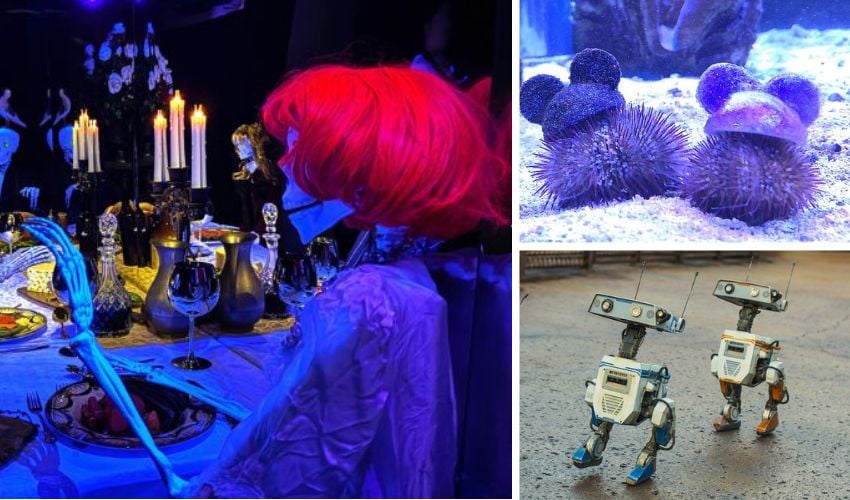
Some people love them, others can’t stand them: amusement parks with extreme roller coasters, spooky attractions, adrenaline rushes, and moments of pure terror. Today, these parks no longer focus solely on the rides; they’re all about the full experience. That’s why the world’s biggest amusement parks attract countless visitors every year with immersive, carefully designed worlds. To make each visit as unforgettable as possible, every detail matters. And increasingly, 3D printing is helping make those details stand out. From wait line decor to restaurant theming and even roller coaster elements, custom 3D-printed designs are creating eye-catching, one-of-a-kind features throughout the parks. In this list, you’ll find some of the most interesting public projects and collaborations involving 3D printing in amusement parks. The real number is likely much higher, as parks don’t always disclose when 3D-printed components and props are used. Still, sharp-eyed visitors often spot them and share their discoveries on social media.
3D-Printed Exoskeletons in Disney Parks
Disney is using 3D printing to create exoskeleton structures for Project Exo, an initiative designed to bring oversized characters to life in its theme parks. The patented invention features a 3D-printed lattice framework that transfers the weight of the costume directly to the ground. This reduces the physical strain on the performer and supports more natural movement during interactions with guests. The system also incorporates a series of on-demand printed “bio-elements” such as muscles, fat, and other biological features. These components help Disney rapidly produce detailed, realistic textures that move and respond convincingly to physical motion and external contact.
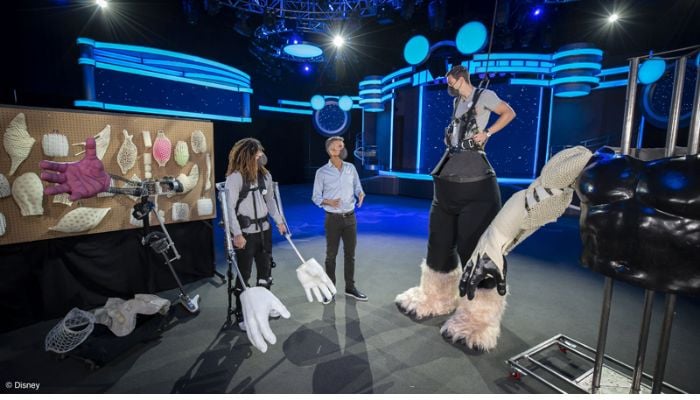
Photo Credit: Disney, Walt Disney Studios
Disney Uses 3D Printing at Connections Café & Eatery in Epcot
At Epcot’s World Celebration, a new blend of technology and history is taking shape at Disney. As part of Epcot’s multi-year transformation, Disney has introduced a intricately designed 3D printed flooring at the new Connections Cafe and Eatery. The restaurant’s decor helps celebrate the innovation and heritage of Epcot. For this project, Disney Imagineers used a sustainable biopolymer material to print the flooring of the cafe. The design is inspired by the original concept of ‘Epcot City’ by Walt Disney, including the original radial layout. The geometrically precise designs were then 3D printed to serve as a template for the inlays, which were later poured by artisans and then sanded and buffed. The result is a dynamic homage to the vision of Epcot and Walt Disney himself. This project is part of a broader initiative by the Walt Disney Company to incorporate new technologies into storytelling. From its concept to creation, the 3D print floors continue to showcase the spirit of evolution, which Walt Disney often called a “living blueprint of the future.”
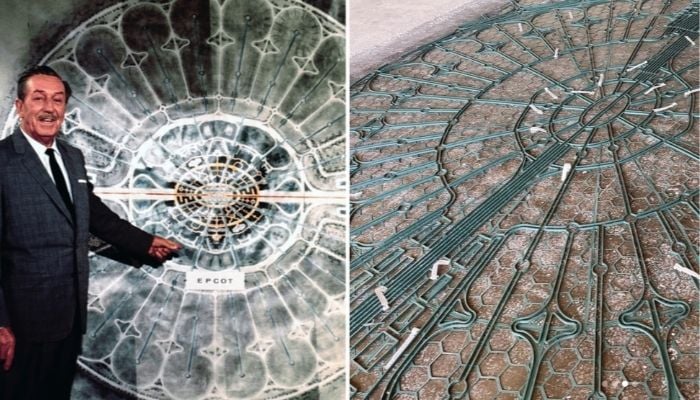
Photo credits: Disney Archives / Zach Riddley via The Walt Disney Company.
Coperni Unveils 3D-Printed Ariel Swipe Bag at Disneyland Paris
In October 2024, fashion house Coperni unveiled a special new piece during its SS2025 runway show at the castle in Disneyland Paris: the 3D-printed Ariel Swipe Bag. This handbag, inspired by the mermaid Ariel, is fully 3D printed. For the printing process, Coperni partnered with Rapid Liquid Print, which used its gravity-free printing technique to produce the bag. The method involves filling a tank with a water-based gel, which stabilizes the silicone during printing. A needle-equipped nozzle is then submerged into the gel and applies the silicone layer by layer to form the bag. The result is a stunningly charming creation.
The Ghost Train Modernized with Bambu Lab Printers
To celebrate its 90th anniversary, the iconic Ghost Train at Luna Park Melbourne was completely renovated using 3D printing. The project was led by designer Edward Félix, who combined technology with craftsmanship to modernize this haunted attraction, one of the oldest of its kind in the world. The process began with a full 3D scan of the ride, allowing experimentation with new designs without risking the physical resources. From there, various elements that set the scene for each part of the train’s journey were 3D printed. Specifically, four candelabras, LED light covers, an entire library, and other hidden structural components were printed using four Bambu Lab X1 Carbon printers. Beyond the aesthetic details, 3D printing made it easier to customize and manufacture all components while staying within budget.
![[Left]: Scene with 3D-printed candelabras. [Right]: Fully 3D-printed fake library. (Credit: Bambu Lab Blog)](https://www.3dnatives.com/es/wp-content/uploads/sites/4/luna_park-melbourne.jpg)
[Left]: Scene with 3D-printed candelabras. [Right]: Fully 3D-printed fake library. (Credit: Bambu Lab Blog)
Lighter Components and Reduced Load at Luna Park (Italy)
Under the leadership of Verona-based company Extreme Analysis Engineering, numerous Italian companies joined forces to carry out the M.P.M.A.G. project (Method of Design and Production in Additive Manufacturing of Complex Components for the Carousel Rides Sector). Among them were ProM and its workshop Polo Meccatronica, Guarnieri, the University of Padua, Exemplar, and many other partners who contributed their expertise. The goal was to use additive manufacturing for amusement parks by producing prototypes through SLM and DED, filing three patent applications, designing an IoT system, and ultimately redesigning a carousel using additive manufacturing. 3D printing drastically reduced the weight of individual components, which significantly lowered the load on the structure. Thanks to 3D printing and the reduced weight, the consumption of motors, brakes, and electricity is also lower compared to conventional manufacturing methods. The result is a new swinging ride in Italian amusement parks, which is an exciting experience that is now even better thanks to the use of 3D printing!
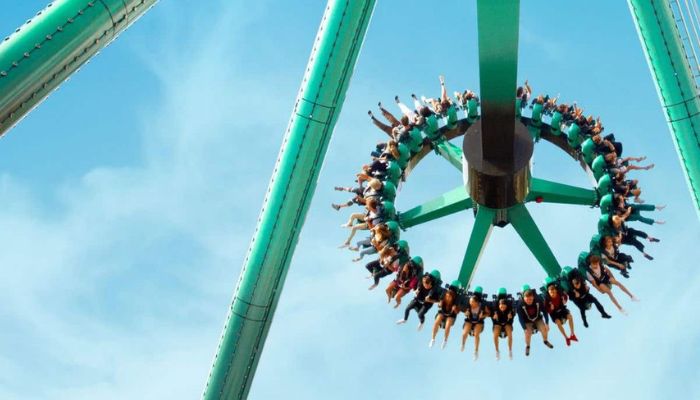
Photo Credit: Luna Park Italia
Disney Embraces 3D Printing at Animal Kingdom Park
At Disney’s Animal Kingdom, innovation supports animal welfare through the integration of modern technologies like 3D printing, motorized mechanisms, and recycled materials. Walt Disney Imagineering’s creative teams work closely with the park’s caretakers to develop new improvements tailored to the hundreds of species living there. The goal is to ensure not only physical and medical care but also mental and behavioral stimulation essential for the animals’ development and well-being.
Among these initiatives is the “cheetah ball,” a motorized device partly designed with 3D printing that awakens the felines’ natural hunting instincts and encourages them to run as they would in the wild. Primates also benefit from specific innovations, such as food puzzles made from recycled materials, which stimulate their curiosity and problem-solving skills while providing engaging and enriching activities.
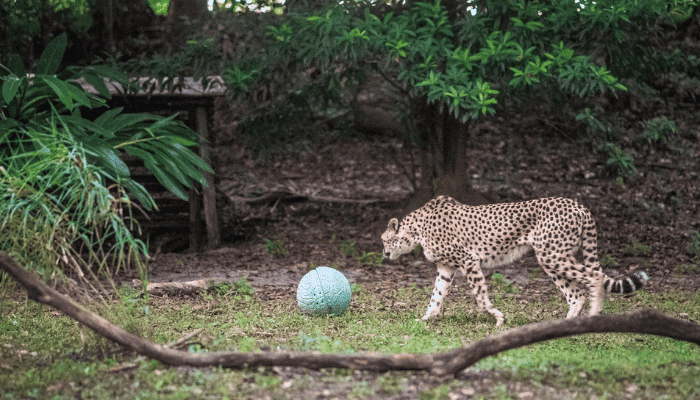
Photo Credit: Thrill Geek
BDX Droids Bring Cuteness to Disney Parks
Originating from the hit series “The Mandalorian” and now roaming all Disneyland parks worldwide, the adorable BDX droids look like they’ve stepped straight off the screen. These robots move with authentic lifelike motion and have quickly become fan favorites among Disneyland visitors. As Kyle Laughlin, Senior Vice President of Walt Disney Imagineering’s Research and Development division, explains, the droids were not designed for a factory; rather, they were designed to spark emotions in people. To achieve this, the robots were carefully programmed with great attention to detail to bring the parks to life. Creating an emotional connection through technology is the core goal of the BDX droids. Disney Research’s Zurich team took on the challenge of designing these charming robots. Many components of the expressive droids are produced using 3D printing, enabling the team to manufacture the robots in record time. The entire process from initial concept to final droid model took less than a year. Thanks to 3D printing technologies, multiple droids can be built very quickly.
What do you think about the use of 3D printing in amusement parks? Let us know in a comment below or on our LinkedIn or Facebook pages! Plus, don’t forget to sign up for our free weekly Newsletter to get the latest 3D printing news straight to your inbox. You can also find all our videos on our YouTube channel.







